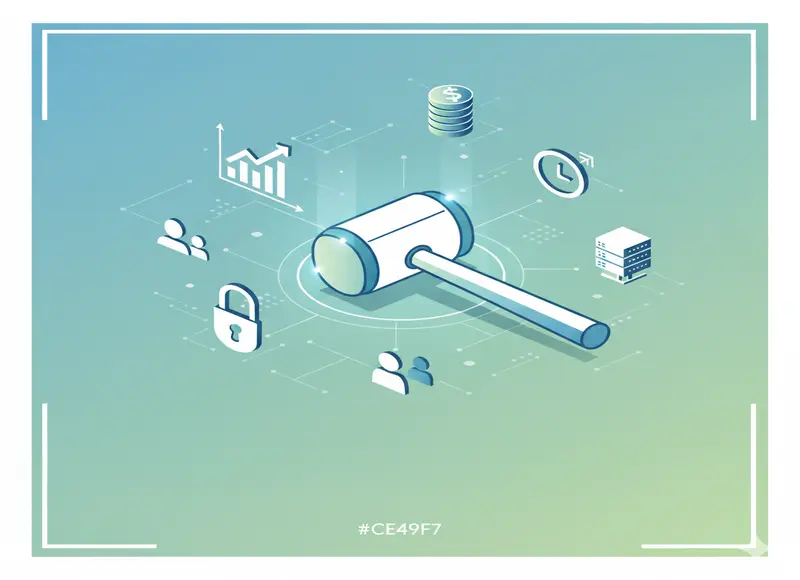Table of Contents
Unlock the power of auction portal development by creating a scalable, secure, and real-time bidding platform that builds trust and drives success.

Digital auctions have transformed their role from being only used in specific applications to becoming an essential tool in business. Many industries, such as automotive, real estate, art, and charity, have adopted them. Today, online platforms are responsible for millions of users, handling monetary transactions, and allowing different sophisticated bidding strategies all over the world.
The goal of auction portal development is to create a reliable, scalable ecosystem that connects buyers and sellers through transparent and efficient transactions. A well-built platform must handle thousands of concurrent bids, provide real-time updates, and maintain strict security for sensitive user data.
Building such a system requires a complement of coding skills. Developers must merge architecture, usability, and business logic in such a way that there is consistency and trust in every engagement between buyers and sellers.
Core Components of a High-Performance Auction Portal
Every auction site is essentially built on underpinning elements that must be present or provided to work harmoniously and ensure efficient operation. These constituents created the mechanisms through which users can actively participate and administrators can efficiently perform all functions.
Essential core modules include:
- User management system: Handles registration, authentication, and role-based permissions for bidders, sellers, and administrators.
- Auction engine: Manages live and timed bidding sessions, including rules, countdowns, and automatic bid increments.
- Product catalog: Displays item listings with images, descriptions, and pricing details.
- Payment gateway: Processes deposits, fees, and settlements securely between users.
If the vendors provide modularity, they must do so to keep speed and reliability there. One failure can ruin an auction, thereby indicating that an architectural emphasis must be laid upon it.
User Experience and Interface Design in Auction Portal Development
Auction participation depends on usability criteria. Users will disengage if navigation is too confusing or response times are slow. Hence, the portal must be designed intuitively for the platform to be successfully adopted.
The interface must have a clear presentation and reduce the number of steps for a user to place a bid or satisfactorily complete transactions. Colors, font, and layout should draw the eye naturally to highly critical elements in an application/interface, like live auctions, buttons for bidding, and notifications.
Design best practices:
- Minimal friction. Simplify registration, bidding, and checkout flows to reduce user drop-offs.
- Responsive design. Ensure seamless access from desktop, tablet, and mobile devices.
- Accessibility standards. Incorporate features for users with disabilities to meet compliance requirements.
Good design turns complex functionality into an intuitive experience that keeps users active throughout the auction lifecycle.
Real-Time Functionality and Bidding Performance
Performance defines the trust of an end user in any auction portal. If bids do not register instantaneously or the entire page takes time to refresh, a participant loses faith. Another way of putting it might be: Real-time is the cornerstone of a working bidding ecosystem.
This is achieved by the developer through the event-driven architecture and communication protocols such as WebSocket, which perform the task of instantaneous transmissions of data. Presently, all participants are visible to updates such as newly registered bids and auction countdowns without having to reload the page.
Key performance considerations:
- Low-latency response: Critical for real-time updates and bid validation.
- Load balancing: Distributes traffic efficiently during peak bidding sessions.
- Caching mechanisms: Speed up data retrieval and reduce server load.
These technical decisions directly affect fairness and transparency, ensuring that all bidders have an equal opportunity to compete.
Security Features That Safeguard the Auction Ecosystem
Since auction platforms handle personal data and financial transactions, robust security protocols are essential. Any vulnerability can undermine user trust and damage a reputation.
It all starts with encrypted data communication, then secure login systems and payment verification, and finally the algorithmic detection of fraud. Developers should also foresee implementing multi-factor authentication and session management in order to avoid such unauthorized access.
Security essentials:
- End-to-end encryption: Protects all data exchanged between users and servers.
- Two-factor authentication: Adds an additional verification step for sensitive operations.
- Anti-fraud monitoring: Detects unusual bidding activity or account behavior.
- Regular security audits: Identify and fix potential vulnerabilities early.
By integrating these measures into the portal’s architecture, developers create an environment where users feel confident participating in transactions.
Data Analytics and Reporting Tools in Auction Portals
Analytics provide actionable insights into bidder behavior, transaction volume, and platform performance. Buyers need the ability to accept or reject bids based on documentation attached to the bid, such as drawings, floors, or elevations. With no data-based visibility, administrators cannot have the pricing strategies optimized or engagement bottlenecks identified.
Auction portals benefit from built-in dashboards that visualize activity metrics, highlight trends, and generate performance summaries automatically. Advanced analytics modules even employ predictive algorithms to forecast bidding interest or demand cycles.
Useful reporting capabilities:
- Bidding statistics: Track bid counts, average increments, and auction conversion rates.
- Revenue analysis: Measure income by category, item type, or auction duration.
- User segmentation: Classify bidders by frequency, region, or spending patterns.
- Real-time monitoring: Detect activity spikes and adjust resource allocation dynamically.
Effective analytics turn operational data into strategic guidance that improves both profitability and user satisfaction.
Integration and Scalability Considerations
A functioning auction portal hardly ever operates in isolation. It must integrate smoothly with the CRM, inventory databases, and any external marketing tools. Proper integration ensures that there is a smooth flow of data while manual updates are rendered unnecessary.
Scalability is equally critical. The bigger the participation in the system, the bigger it must become in order to achieve a reasonable functioning level. However, it should not detract from performance. Cloud Hosting, a composed microservices architecture, and container-based deployment approach allow one to dynamically scale the application based on actual traffic demand.
Integration and scalability strategies:
- API connectivity: Allows third-party tools like payment processors or analytics services to connect easily.
- Modular design: Facilitates updates without downtime or full-system redeployment.
- Elastic cloud infrastructure: Allocates computing resources automatically during high-demand periods.
- Cross-platform compatibility: Ensures consistent functionality across web and mobile environments.
Building with scalability in mind helps organizations avoid performance issues as their user base and transaction volume increase.
Maintenance, Support, and Future-Proofing the System
Once launched, an auction portal requires continuous monitoring and improvement. Regular maintenance ensures that software stays secure, responsive, and aligned with changing business needs.
Support includes fixing bugs, optimizing database performance, and updating frameworks. Over time, the expert developers incorporate user feedback to refine interfaces or add requested features.
Ongoing maintenance practices:
- Scheduled updates: Keep server software, APIs, and security certificates current.
- Performance audits: Test system responsiveness under varying loads.
- User feedback loops: Collect suggestions through surveys and support channels.
- Version control: Maintain a clear record of system changes and rollbacks.
Future-proofing means adopting technologies that accommodate evolving user expectations.
Final Word
A mere buildout for a bidding auction is not enough to develop an auction portal. The development spells out the entire bidding ecosystem with the utmost transparency, performance, and trust of the user. Each element, going from the architecture, the design, accounting, and scalability, plays a co-dependent role for overall efficiency.
Software Companies that promote strategic development should seek long-term systems that can withstand market changes and technological developments. High-performance portals attract participants and keep their confidence such that each auction works in a fair, efficient, and reliable manner.
Recent Blogs
12 Best MethStreams Alternatives for Safe and Reliable Sports Streaming in 2026
-
18 Dec 2025
-
12 Min
-
36
Real World Digital Transformation Use Cases in Real Estate, Tech, and Recruiting
-
17 Dec 2025
-
6 Min
-
143








